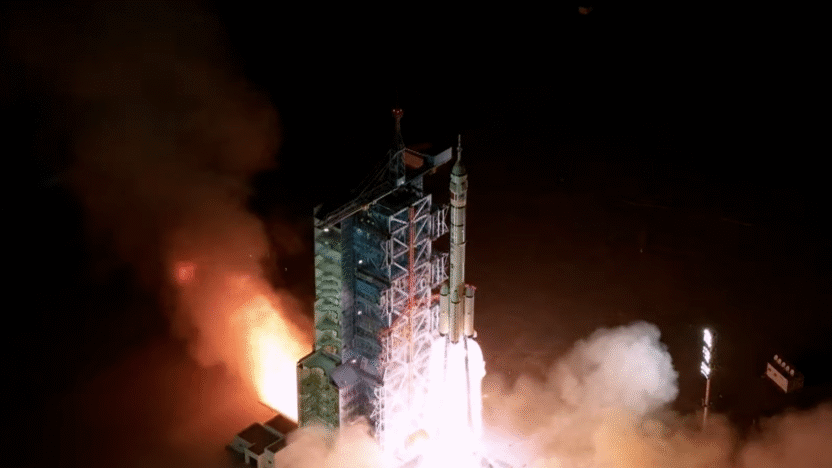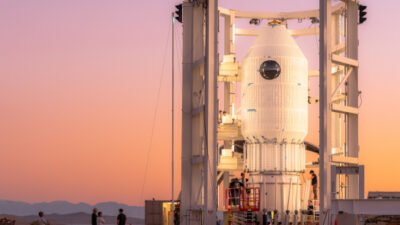24
China has launched its tenth crew to the Tiangong space station. This was the 16th crewed spaceflight for China’s Shenzhou program overall, which has continually occupied the orbiting outpost since June 2021.
The China Manned Space Agency (CMSA) announced the names of the three taikonauts the day before launch. Shenzhou-21 will be commanded by Zhang Lu, who was previously a crew member of Shenzhou-15 almost three years ago.
The commander is joined by two members from the third batch of taikonauts, selected in 2020. Flight Engineer Wu Fei, an engineer at the China Academy of Space Technology, has become the youngest taikonaut to fly at age 32. Payload specialist Zhang Hongzhang, a new-energy researcher at the Dalian Institute of Chemical Physics, will conduct self-designed experiments during the mission.

Shenzhou-21 Crew, Left to Right: Zhang Hongzhang, Commander Zhang Lu and Wu Fei (Credit: Xinhua)
The crew will conduct 27 new experiments during their rotation, including China’s first study of rodent mammals in orbit. Four mice will accompany the crew to study the effects of microgravity and enclosed space on these animals, who will later return with the Shenzhou-20 crew. The trio will also greet the visiting Tianzhou-10 cargo spacecraft and, at the end of their six-month stay, the crew of Shenzhou-22.
The Shenzhou-21 launched aboard a Chang Zheng 2F/G (CZ-2F) on Friday, Oct. 31, at 11:44 PM CST (15:44 UTC). The vehicle lifted off from Site 901 at the Jiuquan Satellite Launch Center in Gansu Province, taking a southeasterly trajectory. This pad is used exclusively for launches of the CZ-2F, carrying either crewed missions or China’s Chongfu Shiyong Shiyan Hangtian Qi experimental reusable spaceplane.
The CZ-2F Y21 vehicle was rolled out to the launch pad on October 24. This is currently China’s only crew-rated launch vehicle. The first stage is supported by four boosters, giving a combined thrust of approximately 6.5 meganewtons. All engines on the vehicle burn Dinitrogen Tetroxide and Unsymmetrical Dimethylhydrazine.

Chang Zheng 2FG vehicle leaves the Vehicle Assembly Building (Credit: CMSA)
Topped by the launch escape system, the rocket stands around 58 meters tall – similar in height to the Atlas V used for Starliner flights, 7 m shorter than SpaceX’s Falcon 9 with Crew Dragon, and roughly the same amount taller than Russia’s crew-carrying Soyuz 2.1a. The CZ-2F vehicle has flown since 1999, though the human-rated CZ-2F/G derivative first flew in 2011 and first carried taikonauts to a space station, Tiangong 1, in June 2012 for the Shenzhou-9 mission. The launcher has the capacity to lift 8,400 kg to low-Earth orbit.
While compact, the Shenzhou spacecraft has a larger internal habitable volume than the Soyuz spacecraft, and is similarly limited to three crew. Recent upgrades have included improvements to the integrated ventilation system, which is built into the taikonauts’ Intra-Vehicular Activity (IVA) suits, replacing the very small boxes that the crew would previously hold. These suits connect to the capsule for services such as power and oxygen. Though they may appear bulky, they weigh less than 20 kg – far lighter than the fully independent Feitian EVA suits that will be worn in microgravity and have at least 100 kg additional mass.
Before leaving the taikonaut dormitory, the crew saluted and formally reported to the Commander in Chief. This ceremony dates back to Shenzhou-5 in 2003 and is witnessed by officials, before the crew departs the Astronaut Systems Engineering Office building just under three hours before launch.

Hatch closing process is completed for Shenzhou-21 (Credit: CMSA/CCTV)
The crew saluted the national flag as they exited the building, mirroring the Soyuz ‘final salute’ but carrying a distinctly military tone – most crew members in China’s space programme are active Air Force officers. After waving to the crowd, they took a short drive in a motorcade of transfer buses to the launch complex, situated around 1.5 km away.
At the pad, the three saluted the camera once more before taking an elevator to the ninth floor of the tower, around 60 m in height, which aligns with a side hatch access level.
Crew ingress began around 140 minutes before launch, and the hatch was closed at around two hours before liftoff. Each crew member will ingress in a particular order due to the confined space within the capsule, with the Commander entering last. Various personnel accompany the crew throughout the pre-launch stages, performing final checks at the pad and supervising suit pressurization.

Launch tower arms open revealing the Chang Zheng 2F/G which will launch the Shenzhou-21 mission (Credit: CMSA/ CCTV)
The tower arms then began to gradually open, revealing the CZ-2F vehicle – a process which completes around 30 minutes before launch.
Following launch, the Shenzhou spacecraft will take approximately three and a half hours to reach the station, arriving around 3:14 AM CST (19:14 UTC) on Nov 1. The space station will conduct the second of two orbital adjustment maneuvers in readiness for the Shenzhou vehicle’s rendezvous on the evening before the launch.
This fast automated rendezvous and docking has been standard since the Shenzhou 14 mission four years ago, to minimize the time in transit for the taikonauts, which previously lasted up to two days.

Mission graphics show the Shenzhou vehicle during a previous mission (Credit: CMSA)
Following a handover ceremony on the station, the three will relieve the Shenzhou-20 crew, who will have spent around 190 days aboard the station. Commander Chen Dong, Operator Chen Zhongrui, and Science Operator Wang Jie have been in orbit since they launched on April 24.
During that time, they conducted around 60 scientific experiments, including studies involving fish, worms, and bacteria, to better understand biological adaptation and ecosystem stability in microgravity. They also conducted four extravehicular activities (EVAs) to install additional protection against space debris and perform routine inspections.
Commander Chen Dong performed his sixth career spacewalk during the third EVA in August, establishing him as the taikonaut who has conducted the most spacewalks to date. The crew matched the record of four EVAs conducted during a rotation, which was first set by Shenzhou-15. He has also become the first taikonaut to spend over 400 days in space, and his crew may even exceed the longest single-mission stay of 192 days, set by Shenzhou-18 in 2024.

Shenzhou 20 taikonaut Wang Jie during the crew’s fourth EVA (Credit: Xinhua/CMSA)
The six taikonauts will spend around a week together before the Shenzhou-20 crew returns to Earth in early November. The return window currently spans between Nov 3 and 9, with a landing expected on Wednesday, Nov. 5, at 12:30 UTC at the time of publishing. The capsule will return to the Dongfeng landing site in north China’s Inner Mongolia Autonomous Region.
The new crew will, similarly, spend around six months on the station and may get to use the new Feitian EVA suits, which were sent up in July aboard Tianzhou-9 but do not appear to have been utilized to date.

Shenzhou 21 Mission Patch (Credit: CMSA)
(Lead image: Chang Zheng 2F/G Y21 launches Shenzhou-21 Mission from Jiuquan Satellite Launch Center on Oct 31, 2025 – Credit : CCTV)





